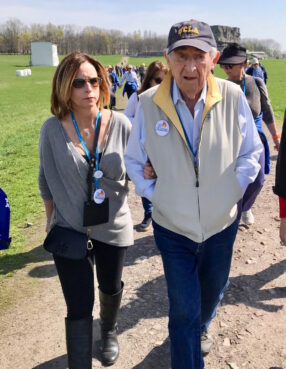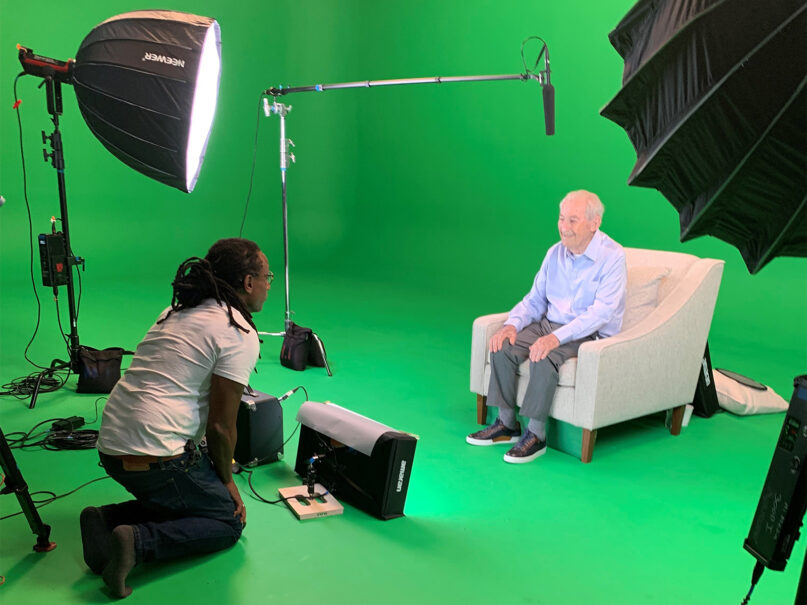(RNS) — David Schaecter is 93 and he is running out of time.
He has dedicated the past 60 years to recounting his struggle for survival in Auschwitz, his escape and how he pieced his life together in the United States after losing his entire family in the Holocaust.
As he marks International Holocaust Remembrance Day on Friday (Jan. 27), Schaecter knows his days of travel and in-person testimony-giving will soon end.
So this week he agreed to a weeklong recording of his life story using a new technology that will allow future generations to interact with a hologram-style likeness of him.
That story will form the base of an exhibit at Boston’s future Holocaust museum, which is scheduled to open in 2025.
“All children, but especially Jewish children, need to know who they are, what they are and what happened,” said Schaecter on a lunch break during the filming in a Miami studio. “I’m the guy who would like to tell them what happened.”
The technology, produced by the USC Shoah Foundation’s Dimensions in Testimonies project, records Holocaust survivors’ answers to about 1,000 questions on individual video clips. Later, using natural-language technology, programmers transform each answer into a search term. In a museum or classroom setting, people can pose a question to a two-dimensional life-size image of the survivor and see and hear the survivor’s answer in real time.
Schaecter is the 62nd Holocaust survivor to undergo the marathon taping for the interactive display. As the number of survivors who can share their stories dwindles, the technology is providing a way for museums and schools to keep the memory of the murder of 6 million Jews by the Nazis and their allies from being forgotten.
Jody Kipnis, the co-founder of a Boston Holocaust museum, said she and her partner Todd Ruderman first experienced the hologram-style technology at the Illinois Holocaust Museum and Education Center in Skokie.
“We knew we wanted that exhibit and we knew we wanted David,” she said. “This is as close to speaking to a Holocaust survivor as (one) can get after the survivors are gone.”
Since the technology first became available 10 years ago, 14 Holocaust museums (including 11 in the United States) have featured exhibits with survivors using the interactive technology.
RELATED: 16 objects from Germany tell story of Holocaust in new ways
Schaecter is an old pro at telling his story. He was among the founders of the Holocaust Memorial Miami Beach and has devoted countless hours meeting with grade school, high school and university students to tell them about his life.

Jody Kipnis, left, with Holocaust survivor David Schaecter. Photo courtesy of Jody Kipnis
When Schaecter was 11, he was taken with his mother, two younger sisters and an older brother from his home in what was Czechoslovakia to the Auschwitz camp in Poland. Upon arrival, he was separated from his mother and sisters and never saw them again. He and his brother spent 18 months in Auschwitz and were transported to the Buchenwald concentration camp near Weimar, Germany, where he spent another two years and where his brother was killed. Schaecter escaped from a train as the Germans were clearing out the camps. He arrived in the United States in 1950 and earned a degree in industrial engineering from the University of California Los Angeles.
In 2018, Kipnis and Ruderman accompanied Schaecter on a trip back to Auschwitz. When they returned, the couple started the Holocaust Legacy Foundation. Last year, they purchased a building along Boston’s historic freedom trail where they plan to create a 30,000-square-foot museum.
Schaecter’s testimony will be the centerpiece but it will include other interactive experiences.
“David inspired us to build this museum,” Kipnis said. “We stood in front of his bunker no. 8, and he said to us: ‘Hear me, listen to me, be my voicepiece and tell my story.’”
For Schaecter, who lost so much, the new technology is a chance to give testimony on behalf of the estimated 1.5 million children under 12 who lost their lives in the Holocaust and will never have a chance to speak.
“Those 1.5 million neshamot,” he said, using the Hebrew plural for “souls,” “need to be remembered.”
RELATED: Teaching teachers about the Holocaust and its lessons for democracy today





